How to water grapes properly?
Vine bushes tolerate drought well due to their powerful and deep root system, but without irrigation they grow and bear fruit worse. Timely watering of grapes has a positive effect on the quantity and quality of the crop, improves frost resistance and plant immunity.
When should you water?
Grapes need watering at different stages of their seasonal development.
- Spring.
At the beginning of the growing season, active growth of roots, shoots and leaves occurs. At this time, the bush should receive a sufficient amount of water.
The first watering is carried out until the eyes come to life. It is important to charge the soil with water in March if the winter was little snow. A dry spring is a reason to moisten the earth in April. The time of awakening of the vine will depend on the water temperature. Cold liquid inhibits the process, and warm liquid accelerates the opening of the kidneys. This nuance must be taken into account if there is a risk of recurrent frost.
A second watering is required about twenty days before flowering. On average, in the spring, moistening is carried out three times.
Advice
It is better to shed the soil well 2-3 times than to do frequent, but scanty moistening.
- Summer.
In the summer, they carry out mainly vegetative irrigation, the main task of which is to maintain optimal humidity in the vineyard.
Watering during flowering and immediately in front of it is not carried out, this can lead to shedding of the ovary and poor pollination. The most active period of moisture consumption is during the filling of berries. At this time, the bush should receive half of the water needed for the season. Moistening is carried out until the berries soften.
Irrigation just prior to ripening of the bunches can lead to cracking and poor sugar accumulation. From the moment when the fruits begin to stain according to their variety, and when the berries ripen, watering is not carried out.
Advice
Improper watering in the hot summer period can harm the grape bush. If you water the heated soil with cold water from a well or a well, the plant will receive a heat shock due to the difference in water and air temperatures. Watering with such water should be carried out in the predawn time, when the ground has cooled as much as possible. The second option for the wrong time for work is irrigation in summer in extreme heat under high pressure, if the water in the hose is well heated. In this case, the grapes can also get stressed.
- Fall.
By watering the grapes in the fall, you will ensure a successful wintering for the bush. Dry soil in winter leads to freezing of the root system, it cracks from frost, which leads to damage to the roots. If autumn is rainy, then the vineyard is not moistened.
In areas with open vineyards, irrigation is carried out when all the leaves on the bushes fall off. In the covering areas, moistening is performed after the "warming" of the vine. The approximate period is the second half of October or early November, before the first frost.
Watering of late varieties, the bunches of which will be used for long-term storage, are stopped in the fall, a month before harvesting.
How much water do you need?
There are no exact norms for watering times and the amount of water used. The scope and timing of these works is influenced by a whole range of factors.
- Features of the climate. In arid regions with seasonal droughts, irrigation is carried out more frequently.
- Soil composition. On light sandy soils, the intervals between waterings are shorter and the portions are smaller. Chernozem and clayey soil are irrigated more abundantly, but less frequently.
- Weather.Even in one region in different years, the amount and volume of irrigation differ depending on the temperature indicators and the amount of precipitation.
- Grape sort. For plants with a late maturity, the amount of watering is usually higher.
- The age and size of the vine, the number of bunches. For example, mature bushes in the summer, during the ripening of berries, need more irrigation than two-year-old seedlings in the same period.
- Watering method.
After a snowless winter, during the spring watering, each bush may need about 250 liters of water. Approximately the same amount of moisture is required if the weather remains dry for a long time, during the main summer watering. The bush consumes a lot of water when the berries are poured.
During vegetative irrigation, on average, vineyards need about 50 liters of water per square meter of area, usually in the range from 40 to 70 liters. On sandy and sandy loam soils, the rate is increased by about one and a half times.
The watering depth should be at least 40 cm so that the plant does not form a superficial root system, which is prone to freezing and does not provide the grapes with the necessary moisture and useful nutrients.
Signs of waterlogging, when which you should reduce watering:
- increased growth of shoots and a large number of stepchildren;
- poor aging of the vine;
- watery berries with low sugar content;
- atypical color in dark grape varieties.
Advice
Experienced gardeners take a soil test under the bush to determine if the plant needs to be watered. The soil is squeezed in a fist - sufficiently moistened earth will not crumble after you open your hand.
Watering young seedlings
Young plants of the first years of life need regular moisture. Immediately after planting, the young grape bush is irrigated about once a week. About 15 liters of water is poured into a round hole up to 25 cm deep during each watering. The width is made about 60 cm. A large hole is not needed, because the roots of the plant are not yet branched.
From the middle of summer, the grown grapes are watered about twice a month. Watering is adjusted depending on weather conditions and the size of the seedling. For good ripening of the vine, irrigation is stopped in August, in the autumn months it is not carried out.
Watering methods for grapes
There are two ways to moisturize grape bushes:
- surface;
- underground.
Irrigation according to the first method is carried out in single irrigation pits or in grooves made at the base of several plants. The depth of the grooves is about 20 cm. This option is not effective enough for large bushes with a deep root system. Moisture simply does not get to the roots located at a depth of more than half a meter. Drip irrigation is a better option. The tape is placed at a distance of about 20 cm from the stem, providing each bush with the optimal amount of water.
The best irrigation option is properly organized underground irrigation. It provides high-quality soil moisture at depth, prevents damage to the bushes during severe frosts due to the active growth of deep roots, reduces the risk of fungal diseases due to the dry surface around the bush. To organize drainage irrigation along the vine row, metal pipes with a diameter of 10-15 cm are dug in to a depth of about 50 cm, leaving part of the pipe above the soil at a height of about 15 cm.About 15 holes with a diameter of about 12 mm are drilled in the lower part of the pipe, without using the upper 20-30 cm pipe. At the bottom, under the pipe, it is recommended to create a drainage layer of broken bricks or rubble. To prevent debris from getting into the pipe, the upper part is kept closed. The method of irrigation through a drainage tube is very economical - with such a system less water is consumed, and the area of humidification increases.
Advice
Sprayers are not recommended for use in the vineyard.They create increased moisture near the bushes, which can lead to fungal diseases.
Features of watering grapes
Some nuances of watering a grape bush should be taken into account.
- Grapes are a moisture-loving plant, however, it is better to underfill than to overmoisten the vine. Excessive watering leads to the development of a shallow root system. Such roots are prone to freezing out during low winter temperatures, and in summer they suffer from a lack of moisture, because the upper layers of the soil dry out quickly.
- If the break between watering is too long, and the earth has time to dry out very much, this leads to a deterioration in the quality of the berries and their cracking.
- With the increased growth of green shoots, watering is reduced, and if they have suspended development, you need to water and fertilize the bushes with nitrogen fertilizers.
- During dry periods, additional watering may be required while softening and coloring the berries.
- The soil is optimally hydrated and the plant grows well if the ends of the vine shoots are curved.
- In the absence of rain and severe droughts, watering is carried out more often, and the volume of water is increased.
- The best time for irrigation is in the evening, and the temperature of water, air and soil should not differ too much. It is useful to moisten with rain or settled water, which is previously poured into large two-liter barrels.
- The next day after watering, it is imperative to loosen the soil under the grape bush to ensure the flow of air to the roots and stop the rapid drying out of the soil. This improves the nutrition of the bush and prevents root decay.
Watering and fertilizing
For an early entry into fruiting and regular high yields, it is necessary to correctly combine watering with grape dressing.
In the spring, you can apply mineral fertilizers and organic matter. It is beneficial to use zinc, nitrogen and phosphorus. They are combined with compost, manure or poultry manure for maximum effect. In summer, watering is also combined with fertilizing the bush, excluding nitrogen.
Natural organic dressing is the best option for grapes. The last time food can be applied no later than two weeks before harvest.
Regular watering is one of the important conditions for growing grapes. Timely and correctly carried out hydration increases the plant's immunity and ensures its long life. Irrigation helps to grow rich crops and regularly enjoy juicy and sweet bunches.
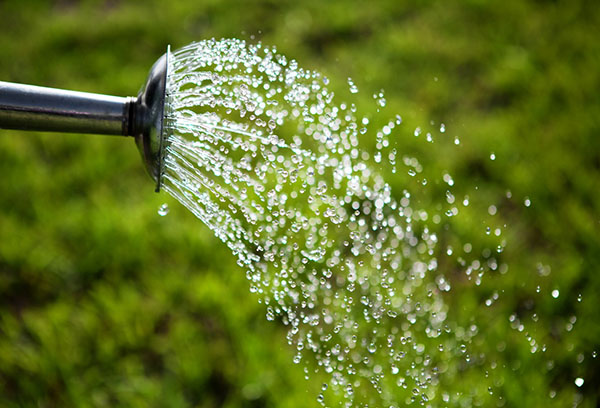
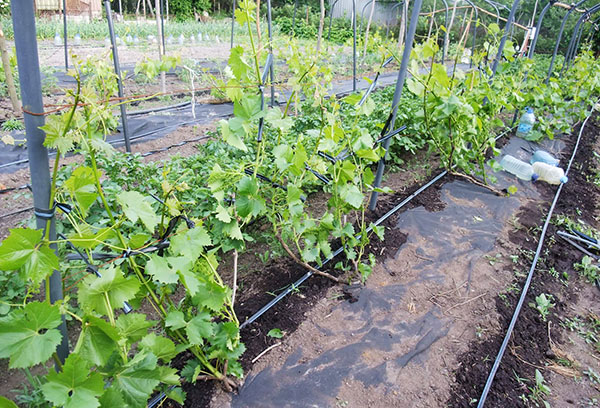

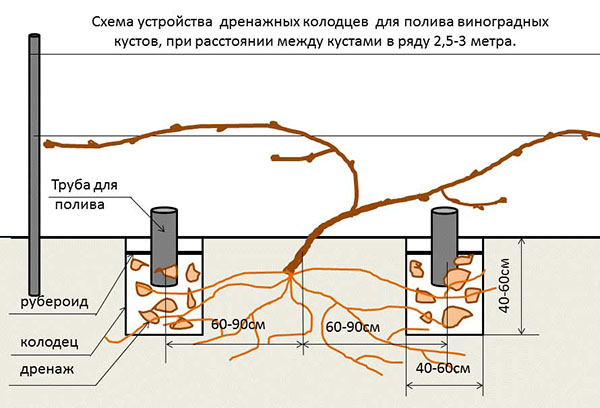
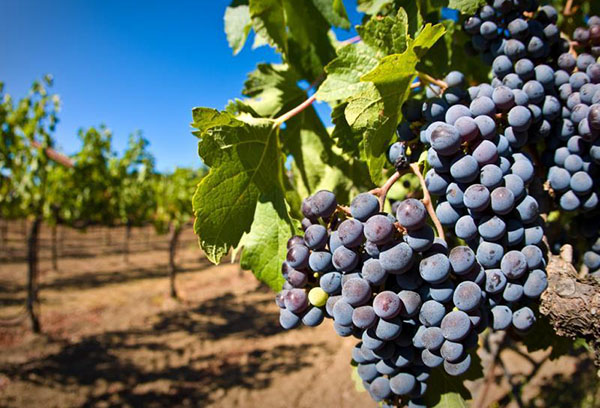
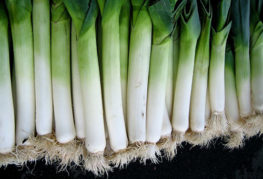

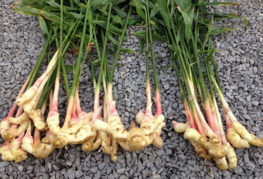

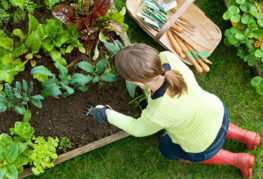
and will be published shortly.